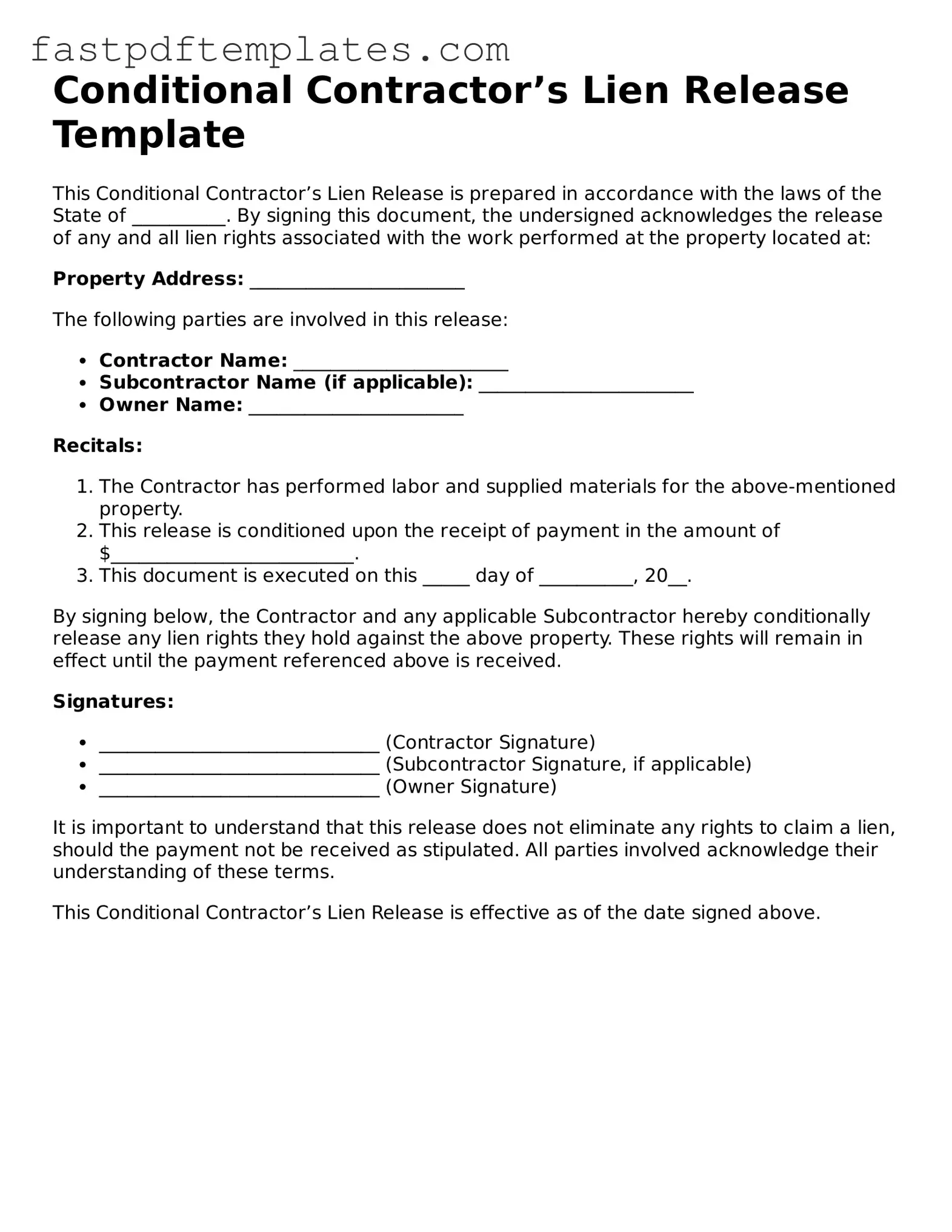The Conditional Contractor’s Lien Release form is similar to the Unconditional Lien Release form. Both documents are used in the construction industry to release claims against a property. However, the key difference lies in the conditions under which they are executed. A Conditional Lien Release is contingent upon the receipt of payment, meaning it only takes effect once the contractor receives the agreed-upon funds. In contrast, an Unconditional Lien Release is effective immediately upon signing, regardless of whether payment has been received. This distinction is crucial for contractors and property owners alike, as it affects the security of payment and the risk of future claims.
Another document akin to the Conditional Contractor’s Lien Release is the Partial Lien Release. This form is used when a contractor has received partial payment for work completed. While the Conditional Lien Release addresses the entire amount owed, the Partial Lien Release only covers the portion of the lien that corresponds to the payment received. By signing this document, the contractor acknowledges that they relinquish their claim to the specified amount, but they may still retain a lien for the remaining balance. This allows for a clear understanding of what has been paid and what is still owed.
The Notice of Intent to Lien is another document that shares similarities with the Conditional Contractor’s Lien Release. While the Conditional Release is used to relinquish a claim, the Notice of Intent serves as a warning that a lien may be filed if payment is not made. This document is typically sent before any lien is actually recorded and provides the property owner with an opportunity to settle any outstanding debts. It emphasizes the importance of communication and serves as a precursor to the more formal lien processes.
The Affidavit of Lien is also comparable to the Conditional Contractor’s Lien Release. This document is used to formally declare a lien against a property when payment has not been received. While the Conditional Release aims to discharge a lien, the Affidavit of Lien establishes a claim for unpaid work. Both documents play critical roles in the payment process within the construction industry, but they serve opposite functions—one releases claims while the other asserts them.
The Final Lien Release is another document that has a close relationship with the Conditional Contractor’s Lien Release. The Final Lien Release is used when all payments have been received and the contractor has completed their work. It signifies that the contractor has no further claims against the property. While the Conditional Release is tied to specific conditions related to payment, the Final Release confirms the conclusion of the contractor’s rights to file a lien, thereby providing peace of mind to the property owner.
The Lien Waiver is similar in purpose to the Conditional Contractor’s Lien Release, as both documents are designed to protect property owners from future claims. A Lien Waiver is often used to waive the right to file a lien for a specific payment. It can be conditional or unconditional, much like the releases mentioned earlier. The Conditional Release is contingent upon payment, while an unconditional waiver relinquishes the right to file a lien regardless of payment status. Understanding the differences between these documents is essential for both contractors and property owners.
The Release of Lien is another document that operates in a similar sphere. This form is used to confirm that a lien has been satisfied and is no longer in effect. While the Conditional Contractor’s Lien Release is executed before payment is received, the Release of Lien is typically signed after payment has been made. Both documents serve to clarify the status of payment and claims, but they do so at different stages of the payment process.
Lastly, the Mechanic’s Lien is closely related to the Conditional Contractor’s Lien Release. A Mechanic’s Lien is a legal claim against a property for unpaid work or materials. While the Conditional Release is a tool to relinquish that claim under specific conditions, the Mechanic’s Lien serves as a means to assert a right to payment. Understanding the relationship between these two documents is vital for navigating the complexities of construction contracts and payment disputes.
